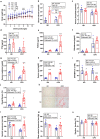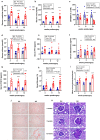A phosphate and calcium-enriched diet promotes progression of 5/6-nephrectomy-induced chronic kidney disease in C57BL/6 mice
- PMID: 34290280
- PMCID: PMC8295299
- DOI: 10.1038/s41598-021-94264-8
A phosphate and calcium-enriched diet promotes progression of 5/6-nephrectomy-induced chronic kidney disease in C57BL/6 mice
Abstract
C57BL/6 mice are known to be rather resistant to the induction of experimental chronic kidney disease (CKD) by 5/6-nephrectomy (5/6-Nx). Here, we sought to characterize the development of CKD and its cardiac and skeletal sequelae during the first three months after 5/6-Nx in C57BL/6 mice fed a calcium- and phosphate enriched diet (CPD) with a balanced calcium/phosphate ratio. 5/6-NX mice on CPD showed increased renal fibrosis and a more pronounced decrease in glomerular filtration rate when compared to 5/6-Nx mice on normal diet (ND). Interestingly, despite comparable levels of serum calcium, phosphate, and parathyroid hormone (PTH), circulating intact fibroblast growth factor-23 (FGF23) was 5 times higher in 5/6-Nx mice on CPD, relative to 5/6-Nx mice on ND. A time course experiment revealed that 5/6-Nx mice on CPD developed progressive renal functional decline, renal fibrosis, cortical bone loss, impaired bone mineralization as well as hypertension, but not left ventricular hypertrophy. Collectively, our data show that the resistance of C57BL/6 mice to 5/6-Nx can be partially overcome by feeding the CPD, and that the CPD induces a profound, PTH-independent increase in FGF23 in 5/6-Nx mice, making it an interesting tool to assess the pathophysiological significance of FGF23 in CKD.
© 2021. The Author(s).
Conflict of interest statement
The authors declare no competing interests.
Figures




References
Publication types
MeSH terms
Substances
Grants and funding
LinkOut - more resources
Full Text Sources
Medical

